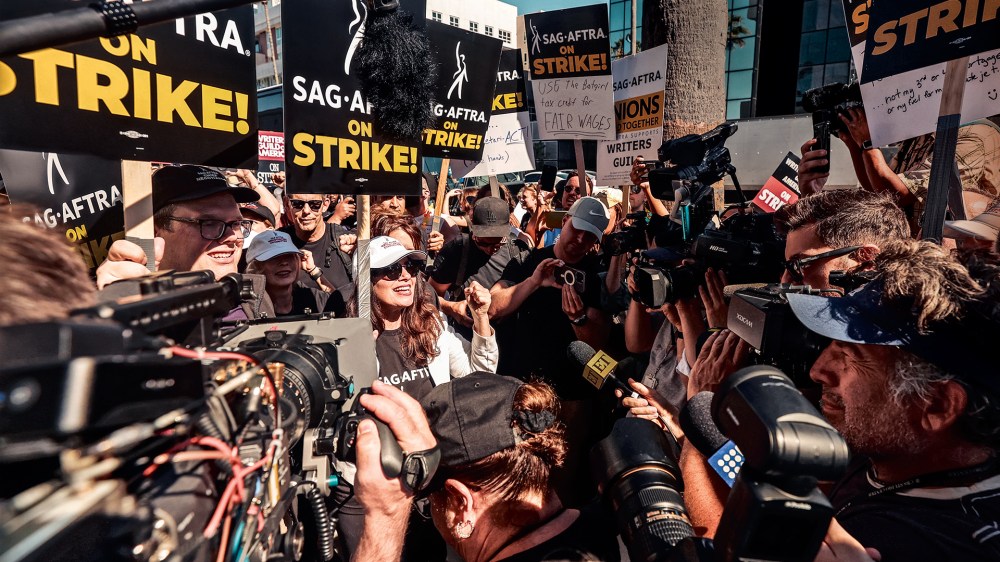This article is more than
1 year oldAs Hollywood’s Season of Strikes Comes to End, What Are the Lessons Learned?

After a work stoppage of record duration, SAG-AFTRA and its largest employers have made peace. Hollywood’s TV and film production machinery is about to be dusted off after a more than six-month furlough that has taxed every sector of the entertainment economy, from union members to local businesses to the largest media conglomerates.
So what have we learned after the long march of the hot labor summer that bleed into an angry, exhausted autumn? In truth, we’ve learned a ton.
The industry’s problems with over-production and the disconnect between capital expenditures and audience return was writ large on SAG-AFTRA and WGA picket lines. Actor after actor who walked picket lines in L.A. and New York described to Variety experiences of getting nickel and dimed, evaded and outright cheated at times while working in the kind of day player, recurring and guest star work that once allowed experienced and well connected thespians to make a solid living in film and TV work, without reaching marquee name status. This year, actors hoisting picket signs with long lists of credits described instances of begging business affairs executives for their fees and leaning on SAG-AFTRA staff to help enforce their contractual rights. The same was true when we talked to rank and file WGA members, at all levels of experience. Shorter episode orders, fewer seasons per series and a vast income gap between above-the-line and below-the-line players made Peak TV an obstacle course for working Hollywood.
These were the human stories of how studio, network and streamer executives were trying to manage an unprecedented tsunami of original content production. The squeeze on workaday actors and writers was especially galling to veterans because it came after years of top name-brand talent raking in record paychecks for limning TV series and streaming movies. Now, the industry will return to work in a much more sober marketplace for content spending. A slew of projects that had been greenlighted before the WGA strike began on May 2 have already been axed by streamers and other outlets. And the shakeout isn’t over.
Another important result of the labor contract cycle has been to ignite the conversation about the legal, moral and ethical lines to draw around generative artificial intelligence technologies. Instead of talking about tech in amorphous terms, the anger and discourse unleashed by the strikes forced Hollywood to discuss in fine detail how AI may affect the employment picture for creatives who work in copyright-based industries. The details of the SAG-AFTRA terms on AI will be studied no doubt as guideposts in the sea of litigation and public policy making that is now under way in the U.S. and around the world
But the biggest takeaway of them all is that the Hollywood labor contract negotiating process needs to be taken apart and rebuilt for the modern era. The ritual and brinksmanship around when negotiations start, when the priorities are narrowed down, how the economic terms are calculated and even the nomenclature around “last, best and final” offers needs a rethink, outside of the pressure-cooker environment of contract talks on a tight deadline.
The WGA went pencils down for 148 days before reaching a deal. SAG-AFTRA was out 118 days, a record for the union for a TV and film strike involving traditional TV and film production (in 2000 a then-separate SAG and AFTRA jointly waged a six-month strike against commercial producers.) These labor actions were the result of untenable industry conditions that accelerated around 2015 and reached a boiling point in 2022 as the great contraction in content spending began.
Labor and management should make a commitment to appoint a kind of bipartisan industry commission to put some real study into a better process that can avert another six-month shutdown blowing a hole in Hollywood’s production pipeline. (We made this case in a cover story a few weeks ago, ICYMI.)
But before that can happen, the focus of business leaders needs to turn to IATSE. The master contract for the union that covers the crew, tech and artisan workers who are vital contributors to every movie and TV program, is set to expire July 31.
IATSE, as the industry will rememember, came closer to striking during its 2021 round of contract negotiations than it had in decades. Hollywood’s essential workers have also born the sacrifice of the prolonged labor strife. The widespread pain caused by production shutdowns only reinforce how the work of Hollywood is woven by many hands. It’s time to draw on the many hard-learned lessons and new contract precedents set this year to find the path spare IATSE and the rest of the business a rerun of this year’s dysfunction.
Keywords
<p>After sparking fears among fans by posting a series of crying photos, Justin Bieber has taken to social media with a huge announcement.</p>
Kendrick Lamar Beat Drake By Being Drake
UN assembly urges Palestine membership after vote
How Kendrick Lamar and Drake changed rap beefs forever Rapid-fire releases and fast pace of modern life elevate diss war to levels unparalleled in hip-hop history.
Taylor Swift concert photo horrifies internet
Sean 'Diddy' Combs asks judge to reject lawsuit alleging rape of 17-year-old girl in 2003
Ukraine finds itself in a grave situation. Russia appears to be advancing
Ellen to make TV comeback after two years
Island nation erupts into violence, three dead
How the West's plan to punish Russian oil backfired




